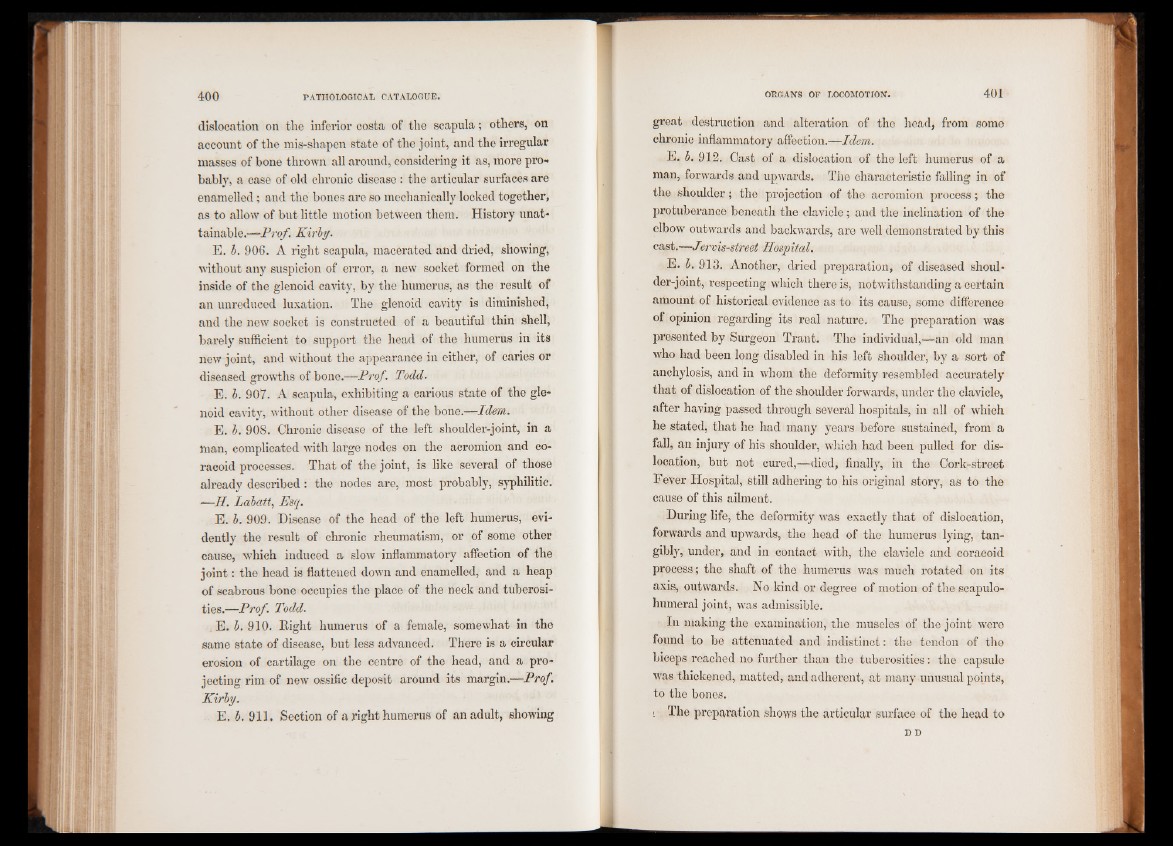
dislocation on the inferior costa of the scapula; others, on
account of the mis-shapen state of the joint, and the irregular
masses of bone thrown all around, considering it as, more probably,
a case of old chronic disease : the articular surfaces are
enamelled; and the bones are so mechanically locked together,
as to allow of but little motion between them. History unattainable.—
Prof. Kirby.
E. b. 906. A right scapula, macerated and dried, showing,
■ without any suspicion of error, a new socket formed on the
inside of the glenoid cavity, by the humerus, as the result of
an unreduced luxation. The glenoid cavity is diminished,
and the new socket is constructed of a beautiful thin shell,
barely sufficient to support the head of the humerus in its
new joint, and without the appearance in either, of caries or
diseased growths of bone.—Prof. Todd.
E. b. 907. A scapula, exhibiting a carious state of the glenoid
cavity, without other disease of the bone.—Idem.
E. b. 908. Chronic disease of the left shoulder-joint, in a
man, complicated with large nodes on the acromion and coracoid
processes. That of the joint, is like several of those
already described: the nodes are, most probably, syphilitic.
-—H. Labatt, Esq.
E. b. 909. Disease of the head of the left humerus, evidently
the result of chronic rheumatism, or of some other
cause, which induced a slow inflammatory affection of the
joint: the head is flattened down and enamelled, and a heap
of scabrous bone occupies the place of the neck and tuberosities.—
Prof. Todd.
E. b. 910. Right humerus of a female, somewhat in the
game state of disease, but less advanced. There is a circular
erosion of cartilage on the centre of the head, and a projecting
rim of new ossific deposit around its margin.—Prof.
Kirby.
E. b. 911. Section of a right humerus of an adult, showing
great destruction and alteration of the head, from some
chronic inflammatory affection.—Idem.
E. b. 912. Oast of a dislocation of the left humerus of a
man, forwards and upwards. The characteristic falling in of
the shoulder; the projection of the acromion process; the
protuberance beneath the clavicle; and the inclination of the
elbow outwards and backwards, are well demonstrated by this
cast.—Jervis-sireet Hospital.
E. b. 913. Another, dried preparation, of diseased shoulder
joint, respecting which there is, notwithstanding a certain
amount of historical evidence as to its cause, some difference
of opinion regarding its real nature. The preparation was
presented by Surgeon Trant. The individual,—an old man
who had been long disabled in his left shoulder, by a sort of
anchylosis, and in whom the deformity resembled accurately
that of dislocation of the shoulder forwards, under the clavicle,
after having passed through several hospitals, in all of which
he stated, that he had many years before sustained, from a
fall, an injury of his shoulder, which had been pulled for dislocation,
but not cured,—died, finally, in the Cork-street
Fever Hospital, still adhering to his original story, as to the
cause of this ailment.
During life, the deformity was exactly that of dislocation,
forwards and upwards, the head of the humerus lying, tangibly,
under, and in contact with, the clavicle and coracoid
process; the shaft of the humerus was much rotated on its
axis, outwards. No kind or degree of motion of the scapulohumeral
joint, was admissible.
In making the examination, the muscles of the joint were
found to be attenuated and indistinct: the tendon of the
biceps reached no further than the tuberosities: the capsule
was thickened, matted, and adherent, at many unusual points,
to the bones.
; The preparation shows the articular surface of the head to
d n